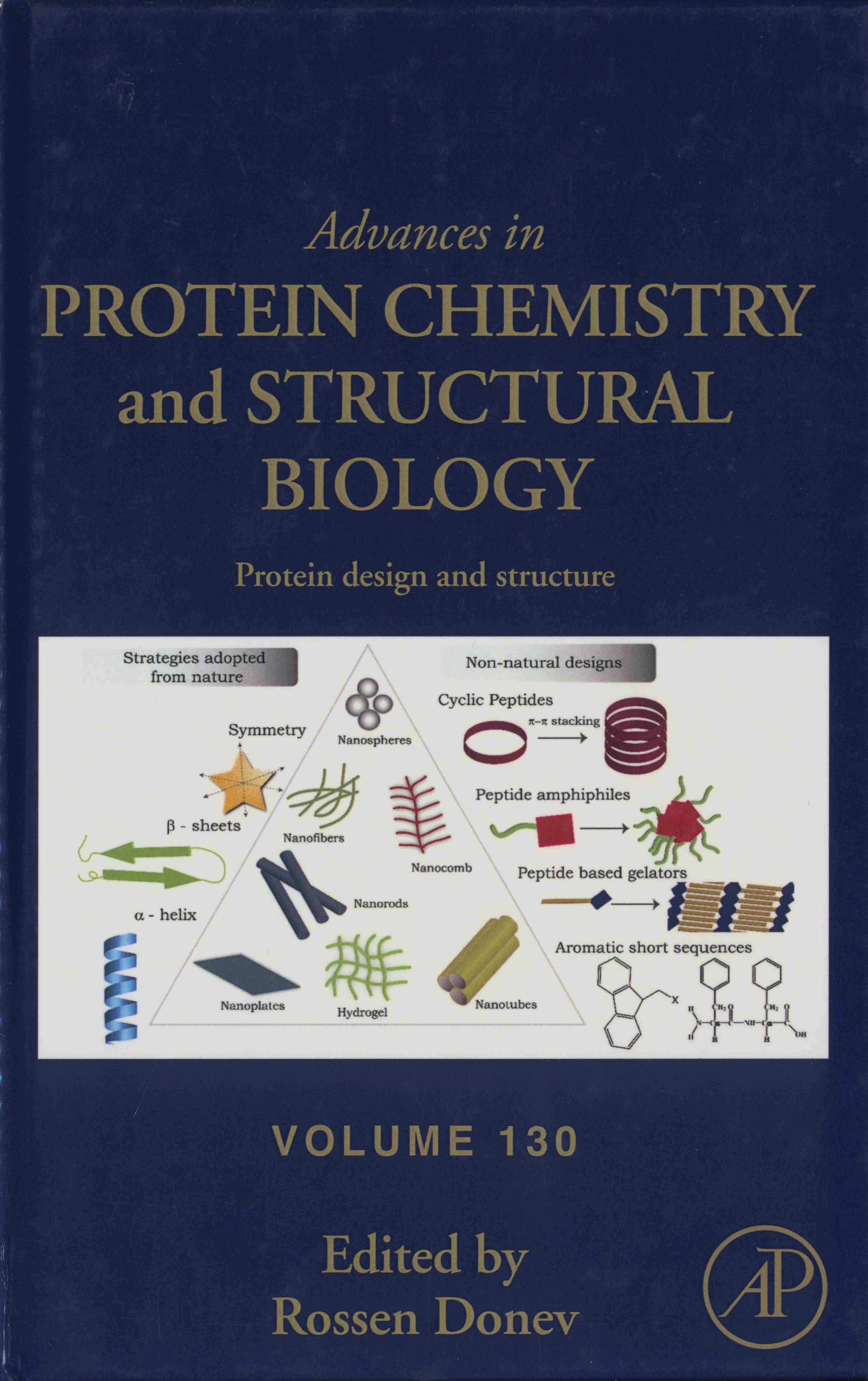 |
Protein design and structure / edited by Rossen Donev -- Cambridge, MA : Academic Press, 2022. – (58.17421/A244p/v.130) |
Contents
Contributors
1. Algorithms for protein design
1. Introduction
2. Applications of protein design
3. Design goals
4. Target function design
5. Algorithms for protein design
6. Software
7. Discussion
8. Conclusion
Acknowledgments
References
2. Computational prediction of protein functional sites Applications in biotechnology and biomedicine
1. Introduction
2. Sequence-based approaches
3. Structure-based approaches
4. Machine learning
5. Conclusions and future trends
Acknowledgments
References
3. Structure and chemistry of enzymatic active sites that play a role in the switch and conformation mechanism
1. Introduction
2. Proteins as drug targets
3. Protein conformations
4. Enzymes in reaction mechanism
5. Enzymes active site
6. Metal and ion oriented active site
7. Substrate binding models
8. Understanding allosteric site and active site
9. Role of charges in active site
10. Reported proteins with active site switches
11. Open and closed conformation in active sites
12. Conformational changes in active sites
13. Role of water in active site
14. Future prospectus
Acknowledgment
References
4. Accelerating therapeutic protein design
1. Introduction
2. Computational design of protein drugs
3. Advances in computational design of therapeutic proteins
4. Outstanding challenges in protein design
5. Perspectives on accelerating therapeutic protein design
6. Conclusions
Acknowledgments
References
5. Aromatic interactions directing peptide nano-assembly
1. Introduction
2. Aromatic interactions in biomolecules
3. History of aromatic stacking
4. Mechanism of amyloid formation through aromatic π-π stacking
5. Strategies adopted and types of building blocks for the construction of bioorganic nanoassemblies
6. Nanostructures formed through aromatic π-π interactions
7. Factors controlling stimulus-response and the formation of nanoassemblies
8. Physical properties of Nanoassemblies
9. Applications
10. Conclusions and future directions
References
6. Understanding binding affinity and specificity of modular protein domains: A focus in ligand design for the polyproline-binding families
1. Modular domains for protein recognition
2. Modular domains for the recognition of proline-rich sequences
3. High-throughput screening strategies for the design of binding partners for polyproline-binding domains
4. Rational design of ligands for polyproline-binding domains
References
7. The structural basis of histone modifying enzyme specificity and promiscuity: Implications for metabolic regulation and drug design
1. The structure of histone modifying enzymes
2. Small molecule inhibitors of histone modifying enzymes
3. Discovery of small molecule and metabolite inhibitors of histone modifying enzymes
4. Discussion
References
8. Designing synthetic transcription factors: A structural perspective
1. Introduction
2. General principles of de novo protein designing
3. Synthetic structural biology
4. General grammar for the structural assembly of STFs
5. STF designs involving zinc fingers
6. STF designs involving basic leucine zippers
7. STF designs involving helix-turn-helix
8. STF designs involving homeodomains
9. Applications of TFs in genetic circuit design
10. Conclusion
References
9. Recent advances in structural studies of 14-3-3 protein complexes
1. Introduction
2. Nomenclature, structure, and functioning of 14-3-3
3. Approaches to obtain 14-3-3 complexes for structural studies
4. Crystal structures of 14-3-3 complexes with partner proteins
5. Cryoelectron microscopy structures of 14-3-3 complexes
6. The protein-peptide binding approach in studying 14-3-3 complexes
7. Chimeric 14-3-3 proteins with phosphorylated peptides
8. 14-3-3 studies by nuclear magnetic resonance
9. Conclusions
Acknowledgments
References
10. Immunosafe(r)-by-design nanoparticles: Molecular targets and cell signaling pathways in a next-generation model proxy for humans
1. Safe(r)-by-design concept for nanoparticle development: Immunological point of view
2. Bio-corona: An important issue in nano-immune interactions
3. Nanoparticle surface functionalization for biomedical use
4. The innate immunity of the sea urchin from the human perspective
5. The sea urchin Paracentrotus lividus: A next-generation model to study the immunosafety of nanoparticles
6. Insights into the molecular targets and cell signaling pathways involved in immune-nanoparticle recognition/interaction of the sea urchin Paracentrotus lividus
7. Concluding remarks
References
11. Mutations in G6PC2 gene with increased risk for development of type 2 diabetes: Understanding via computational approach
1. Introduction
2. Materials and methods
3. Results and discussion
4. Conclusion
Conflict of interest
Author contributions
Funding
Acknowledgments
References
12. Computational structural assessment of BReast CAncer type 1 susceptibility protein (BRCA1) and BRCA1-Associated Ring Domain protein 1 (BARD1) mutations on the protein-protein interface
1. Introduction
2. Materials and methods
3. Results
4. Discussion
5. Conclusion
Acknowledgment
Funding
Author contributions
Conflict of interest
References
13. Evolutionary aspect of Miltefosine transporter proteins in Leishmania major
1. Introduction
2. Methodology
3. Results
4. Discussion
Acknowledgment
Authors contribution
References